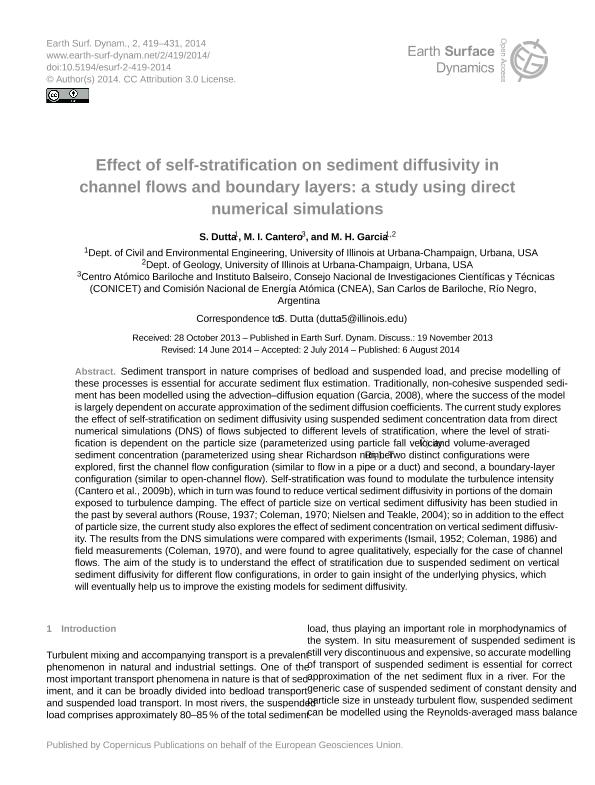Mostrar el registro sencillo del ítem
dc.contributor.author
Dutta, S.
dc.contributor.author
Cantero, Mariano Ignacio

dc.contributor.author
García, Marcelo Horacio

dc.date.available
2017-12-01T18:32:03Z
dc.date.issued
2014-08-06
dc.identifier.citation
Dutta, S.; Cantero, Mariano Ignacio; García, Marcelo Horacio; Effect of self-stratification on sediment diffusivity in channel flows and boundary layers: a study using direct numerical simulations; European Geosciences Union; Earth Surface Dynamics; 2; 2; 6-8-2014; 419-431
dc.identifier.issn
2196-6311
dc.identifier.uri
http://hdl.handle.net/11336/29483
dc.description.abstract
Sediment transport in nature comprises of bedload and suspended load, and precise modelling of these processes is essential for accurate sediment flux estimation. Traditionally, non-cohesive suspended sediment has been modelled using the advection–diffusion equation (Garcia, 2008), where the success of the model is largely dependent on accurate approximation of the sediment diffusion coefficients. The current study explores the effect of self-stratification on sediment diffusivity using suspended sediment concentration data from direct numerical simulations (DNS) of flows subjected to different levels of stratification, where the level of stratification is dependent on the particle size (parameterized using particle fall velocity Ṽ and volume-averaged sediment concentration (parameterized using shear Richardson number Riτ. Two distinct configurations were explored, first the channel flow configuration (similar to flow in a pipe or a duct) and second, a boundary-layer configuration (similar to open-channel flow). Self-stratification was found to modulate the turbulence intensity (Cantero et al., 2009b), which in turn was found to reduce vertical sediment diffusivity in portions of the domain exposed to turbulence damping. The effect of particle size on vertical sediment diffusivity has been studied in the past by several authors (Rouse, 1937; Coleman, 1970; Nielsen and Teakle, 2004); so in addition to the effect of particle size, the current study also explores the effect of sediment concentration on vertical sediment diffusivity. The results from the DNS simulations were compared with experiments (Ismail, 1952; Coleman, 1986) and field measurements (Coleman, 1970), and were found to agree qualitatively, especially for the case of channel flows. The aim of the study is to understand the effect of stratification due to suspended sediment on vertical sediment diffusivity for different flow configurations, in order to gain insight of the underlying physics, which will eventually help us to improve the existing models for sediment diffusivity.
dc.format
application/pdf
dc.language.iso
eng
dc.publisher
European Geosciences Union
dc.rights
info:eu-repo/semantics/openAccess
dc.rights.uri
https://creativecommons.org/licenses/by-nc-sa/2.5/ar/
dc.subject
Dns
dc.title
Effect of self-stratification on sediment diffusivity in channel flows and boundary layers: a study using direct numerical simulations
dc.type
info:eu-repo/semantics/article
dc.type
info:ar-repo/semantics/artículo
dc.type
info:eu-repo/semantics/publishedVersion
dc.date.updated
2017-09-29T16:36:03Z
dc.journal.volume
2
dc.journal.number
2
dc.journal.pagination
419-431
dc.journal.pais
Alemania

dc.journal.ciudad
Munich
dc.description.fil
Fil: Dutta, S.. University of Illinois. Urbana - Champaign; Estados Unidos
dc.description.fil
Fil: Cantero, Mariano Ignacio. Comision Nacional de Energia Atomica. Fundación Jose A. Balseiro; Argentina. Consejo Nacional de Investigaciones Científicas y Técnicas; Argentina
dc.description.fil
Fil: García, Marcelo Horacio. University of Illinois. Urbana - Champaign; Estados Unidos
dc.journal.title
Earth Surface Dynamics
dc.relation.alternativeid
info:eu-repo/semantics/altIdentifier/doi/http://dx.doi.org/10.5194/esurf-2-419-2014
dc.relation.alternativeid
info:eu-repo/semantics/altIdentifier/url/https://www.earth-surf-dynam.net/2/419/2014/
Archivos asociados
